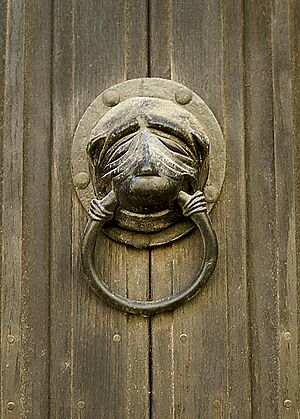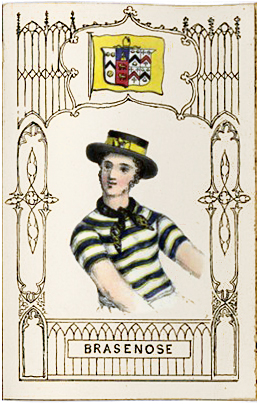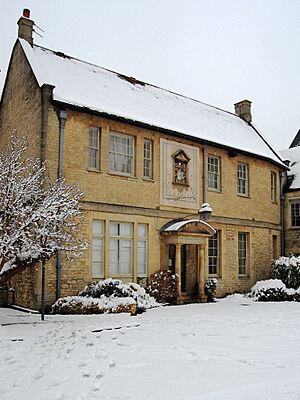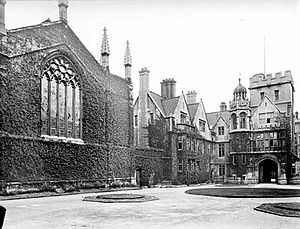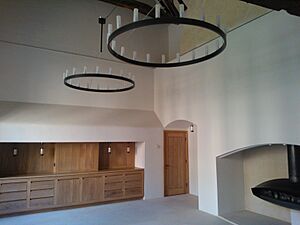History of Brasenose College, Oxford facts for kids
Brasenose College, Oxford, has a long and interesting story, starting way back in 1509. That's when it was founded on the spot where an old building called Brasenose Hall used to be. Its name probably comes from a cool bronze door knocker shaped like a nose!
The college had strong ties to the counties of Lancashire and Cheshire. This was because its two founders, Sir Richard Sutton and Bishop William Smyth, came from those areas. This connection lasted for a long time. Early leaders helped Brasenose College get through big changes like the Reformation, a time of major religious shifts in England.
During the English Civil War, most people at Brasenose supported the King (Royalists). But the college also had important people on both sides of the conflict. Even with money problems, the college managed to finish building its library and chapel in the mid-1600s.
After 1785, Brasenose became much more successful under Principal William Cleaver. More wealthy students joined, and the college's money doubled between 1790 and 1810. Students also did very well in their studies. Later, in the late 1800s and early 1900s, new buildings like the New Quad were added.
Even though Brasenose was financially stable, its academic success went down for a while under Principal Edward Hartopp Cradock. During this time, the college was famous for its sports, especially cricket and rowing. When Charles Buller Heberden became principal in 1889, he helped Brasenose improve its academics again, though its sports performance wasn't as strong. He was the first principal who wasn't a clergyman. He made the library open to students and started entrance exams.
Brasenose lost many students in the First World War, with 115 men dying. After the war, reforms helped the college. William Stallybrass, a key figure, led the college between the wars. Brasenose once again had top athletes, but this sometimes meant academic standards suffered, and money was tight.
The 1970s brought big changes. Women were first admitted in 1974, and there were more postgraduate students. The college also built more housing so all students could live on campus throughout their studies. Law and a new subject called Philosophy, Politics and Economics (PPE) became very strong subjects at Brasenose. The college's finances improved, setting it up well for the 21st century with good academic and extracurricular success.
Contents
College's Beginnings and Early Years
The name "Brasenose" likely comes from a brass door knocker shaped like a leopard or lion's head. One version of this knocker now hangs in the main dining hall of Brasenose College. Some people thought the name came from "brewhouse," but this idea isn't widely accepted.
In 1333, during some unrest in Oxford, a group of students from Brasenose Hall left and tried to start a new university in Stamford. They even took the Brasenose knocker with them! The King ordered them to return, but some stayed in Stamford. The knocker was finally brought back to Oxford in 1890.
How the College Started
Brasenose College was officially founded in 1509. Its founders were Sir Richard Sutton, a lawyer, and William Smyth, who was the Bishop of Lincoln. The first stone for the college was laid on June 1, 1509. King Henry VIII gave them a special royal charter in 1512.
The founders leased the land for the college from University College. Bishop Smyth had become very important in the Church and as a leader. The old Brasenose Hall stayed standing while the new college buildings were finished. The last leader of the hall, Matthew Smyth, became the first leader of the new college.
The college was meant to help "poor and needy scholars" study philosophy and theology. The founders wanted it to be a place for learning and to support the Christian faith. Bishop Smyth had planned for a larger college, but Sir Sutton made it smaller, with a principal and twelve fellows (teachers). The principal had to be over thirty, a graduate, and a priest. Students entering the college were often only 11 or 12 years old.
Early Days of the College
The college kept its strong ties to Lancashire and Cheshire. Many students came from these areas, especially from Prestbury and Prescot, where the founders were born. Other people also gave money to support students from different parts of England.
The original buildings took time to complete. The main hall wasn't finished until the late 1600s. The rooms were simply decorated. The first chapel was used by 1521, and the Old Library was finished around 1520. It held many books, mostly given by generous people.
The first two principals, Matthew Smyth and John Hawarden, helped the college through the difficult time of the Reformation. The college had many people who still supported the old Catholic ways. However, the college slowly accepted the new religious changes. Later, Brasenose became home to important Protestant figures. But it also had many Catholic supporters. Six fellows from Brasenose were even executed for their loyalty to the Pope.
The 1600s
The Civil War Years
The English Civil War began in 1642. Oxford was occupied by the Parliamentarian army. Brasenose College had members who fought on both sides of the war, but most supported the King (Royalists).
After the war, the university was reformed by the Parliamentarians. Brasenose had to remove some of its loyal Royalist members. The college leaders tried to resist these changes, but many fellows were eventually expelled. Despite these challenges, Brasenose College managed to survive.
The college had financial problems during this time, owing a lot of money. It even loaned £600 to the King, which it never got back. However, after the war, the college's money situation slowly got better with help from the government.
In the 1630s, an extra floor was added to the Old Quad. The current chapel and library were built between 1656 and 1666. The chapel was a mix of old Gothic and new Baroque styles. These building projects cost a lot, but by 1680, the college's income was stable.
After the King Returned
After the King returned to power in 1660, Brasenose quickly adapted. The college remained one of the largest in the university. Many students still came from Lancashire and Cheshire. In 1679, the Duchess of Somerset gave money to fund scholarships for students from Manchester.
This period saw a renewed focus on teaching at the university. Some famous visitors included the French doctor Samuel de Sorbière and the English writer Samuel Pepys.
The Glorious Revolution
When William III and Mary II became rulers in 1688, Oxford became a center for the new government. Brasenose accepted this change smoothly. The college remained loyal to the church. In 1691, William Hulme gave land to support four scholarships for "the poorest sort" of students from Lancashire.
The 1700s
Throughout the 1700s, Brasenose remained loyal to the King, but also had some secret supporters of the old royal family. More than half of the students came from the north of England, especially Lancashire and Cheshire. Most students were from lower-income families.
In 1710, Robert Shippen became principal. He was a strong supporter of the old royal family. He helped the college buy new properties and build a new common room for the fellows. He also played a key role in planning the Radcliffe Camera, a famous library building in Oxford.
Not much changed at Brasenose until 1785. The college began to improve its reputation and became wealthier. Its income increased significantly. The Radcliffe Camera opened in 1749, which helped the college. Social differences between students became less strict.
In 1785, William Cleaver became principal. He wanted Brasenose to be a place for wealthy students. Under his leadership, the number of students grew a lot, and more gentlemen joined the college. The college's income more than doubled between 1790 and 1810.
The Phoenix Common Room, the oldest dining club in Oxford, was founded at Brasenose in 1782. It was a social club for students.
The 1800s
The Regency Period
Cleaver and his successor, Frodsham Hodson, tried to redesign the front of Brasenose College on High Street, but their plans were too expensive and never happened. In 1808, the exiled King Louis XVIII of France visited Brasenose. In 1814, the royal families of the United Kingdom, Russia, and Prussia dined at the Radcliffe Camera, with Brasenose organizing the food.
Brasenose had a very good academic record during this time. It was one of the top colleges in Oxford for both popularity and academic success.
Life at Oxford became more serious and orderly between 1818 and 1837. Brasenose kept its lively reputation for a while, but eventually, a more Victorian sense of morality took over.
Ashurst Turner Gilbert became principal in 1822. He focused on keeping the college politically neutral and following mainstream Anglican beliefs.
The Victorian Era
Richard Harrington became principal in 1842. The college was in good shape, with a high income. Academic reforms were happening across Oxford, and Brasenose's number of top degrees went down.
Edward Hartopp Cradock, known as "Chief," became principal in 1853. He led the college until 1886. During his time, organized sports became very important at Brasenose. The college became famous for its sports, especially rowing and cricket. Many students became "blues" (top university athletes). Brasenose also did well in rugby and football.
The college strongly opposed the first Royal Commission in 1850, which looked into standards at Oxford and Cambridge. Brasenose felt the commission didn't have the right to interfere. However, the college later agreed to many of the commission's suggestions, like reducing living expenses.
The college's finances were strong. Its income was around £16,000, mostly from land and other properties. Even when the economy was tough later in the century, Brasenose was okay because it had less income from farming. To make up for any financial dips, Brasenose increased its student numbers by 1875.
Between 1886 and 1911, new buildings were added, including the New Quad. Frewin Hall was also rebuilt.
Charles Buller Heberden became principal in 1889. He believed sports were good for students' character, but he also brought back a focus on strong academics. The college became more disciplined. Heberden was the first principal who was not a clergyman. The library was opened to all students in 1897, and fellows were given the right to take time off for research.
Early 1900s
Before the First World War, Brasenose continued to focus more on academics. Its rowing teams weren't as strong. In 1901, the college started entrance exams. New scholarships, called Rhodes Scholarships, were created in 1904.
Brasenose suffered greatly in the First World War. Out of 661 members who served, 114 were killed. More than a quarter of the students from the 1913 year died. By 1918, Brasenose had only eight students left.
Between the World Wars
After the war, Brasenose adapted to changes at the university. Greek was no longer a required language, women were allowed to earn degrees, and the university started accepting government funding.
William Stallybrass was a very important figure at Brasenose between the wars. He was a keen sportsman and helped Brasenose become successful in rowing, rugby, and cricket again. However, this focus on sports sometimes meant academic standards fell.
In the 1930s, Brasenose didn't have many top academic results, except in law, where it was excellent. Most students were from middle-class families and independent schools. However, Brasenose also had students from other countries, like British India.
The Second World War
During the Second World War, Brasenose was a smaller community. The college hosted military personnel. Many students joined the Royal Air Force. Brasenose had a high number of deaths in this war, with 123 members killed.
After the war, there were big changes in education. Government support for students increased a lot, and more students from state schools were able to attend. This led to much more competition for places at the university.
Late 1900s
Brasenose's finances were not great at the start of the second half of the century, but they improved. The college had a lot of students, but academic results were often poor.
In the 1970s, Herbert Hart became the first principal chosen from outside Brasenose. Later, Lord Windlesham, who had been a government minister, became principal in 1989.
Brasenose kept its strong reputation for law. Other subjects like English literature and Philosophy, Politics and Economics (PPE) also became very strong. Many top academics joined the college.
Even with famous academics, Brasenose's academic results were still low in the 1960s and 1970s. However, by 2001, Brasenose had climbed to third place in the Norrington Table, a ranking of colleges by academic performance.
Sports achievements declined in the late 1900s, especially in rowing and cricket. But in the 1990s, rowing started to do well again, first with the women's team and then the men's. Outside of sports, a young Jeffrey Archer successfully invited The Beatles to Brasenose for a charity event!
In the 1960s, the college became more open. Women students were first admitted in the 1974-1975 academic year. The college also became more secular, meaning it was less focused on religious matters. More students from state schools joined, and the college's old link with the north-west of England became less important. More students from other countries also started coming to Brasenose.
Brasenose started a new building program to house more students. New buildings were constructed in a modern style. The Frewin site also got new rooms. By 1997, the college could house all its students for their entire degree. The college's finances were strong, and it entered the 21st century in a good position.
The 2000s
Professor Roger Cashmore, a scientist, became Brasenose's first principal from a science background in 2003. He was followed by Alan Bowman in 2011. Between 2010 and 2012, the area around the kitchen was rebuilt, along with other dining and living spaces. This project was called "Project Q."


